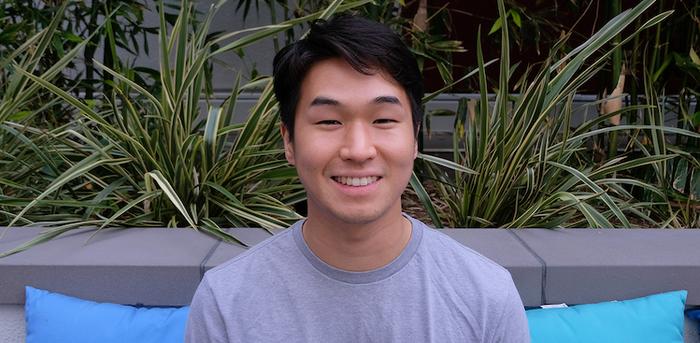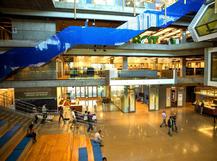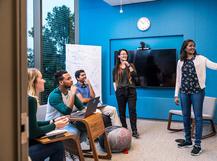
During his undergraduate years at Carnegie Mellon University, Brandon Lee switched majors—twice. First he went from biology to mathematics, then from math to statistics and machine learning.
“Neither of those sounds like a traditional path to a design career, right?” he laughs. Eventually, Lee came across a program called Human-Computer Interaction and learned about what it takes to solve user-centered problems. He ended up double majoring in this field. “This field of work involves leveraging data, conducting research, designing, prototyping, and building, I felt particularly attracted to the process of understanding problems to drive and craft user experiences,” Lee says.
While in college, he interned at Intuit and got experience on their Futures team as a design technologist, where he co-led a data visualization project through all phases of research, design, and advanced prototyping. And when he graduated, he returned to Intuit and joined the QuickBooks Capital team helping small businesses get much-needed access to funding. “The company is full of extremely talented individuals,” he says. “Add to that the company culture, the strong emphasis on work-life balance, the high value placed upon design, and the vast mentorship available for personal growth—those were just some of the many factors that made me feel confident about returning to Intuit full-time after my internship.”
Today, Brandon is a product designer on the QuickBooks Payroll team, supporting small business owners with payroll, taxes, benefits, and more.
Read on to trace his career trajectory, and follow his advice on finding your voice—and making an impact.

What attracted you to work at Intuit?
I was very drawn to Intuit’s mission to power prosperity around the world. When you think about some of the products that we work on—TurboTax, which helps users confidently file taxes and maximize returns; Mint, which helps users budget and manages their finances; or QuickBooks, which helps users run their small businesses—the opportunity to help people feel empowered about their finances is something that I wanted to be a part of.
What are you responsible for as a product designer?
As a product designer, it’s essential that I’m well-versed in our end-to-end experiences and continuously investigate how our customers are using them through research and data. That way, I can help identify opportunities for improvements and influence our business priorities. Outside of research, I’m also responsible for designing the experiences that our customers engage with. This includes staying on top of the best design practices, not only within our organization but across the industry. With new innovations constantly being introduced, it’s my responsibility to be ahead of those trends and be a leading and guiding voice behind our user experience.
Product design is a very iterative process: identifying challenges that exist in the experience today, collecting data points and user feedback to extract insights, brainstorming how we might solve or improve an experience, testing and validating our designs with users, and eventually shipping the product when we are confident that we can bring value to the customer experience.
What are some notable wins at Intuit, and how did your team accomplish them?
When I was on the QuickBooks Capital team, we learned that our customers often viewed business funding in a negative light. Seeking money outside of their own pockets equated to asking for help, which to them was a sign of weakness. But in reality, additional capital can be strategically used to invest more into the business and allow them to start playing offense with their money rather than defense.
We used this insight to fuel a redesign of our Capital landing page, which leaned much more on product benefits, how it works, and ideas on how small businesses could potentially use additional business funding. Not only did this lead to an increase in applications started, but it meant that we were providing additional funds to more of our small business customers.
You also help out the larger organization by teaching basic coding and prototyping to other designers. How do the teams work together?
At Intuit, it’s pretty common to see designers from different teams meeting up, chatting, and helping each other out. All of our designers also work very closely with our design system team. To create cohesive experiences and establish one Intuit identity throughout all of our products, it’s important that we regularly connect with this team for guidance and resources.
Teaching basic coding and prototyping to other designers was one way that I was able to connect with many folks across the organization. While I was on the Capital team, I set up these learning sessions for anyone on my immediate team and other teams across the company, which was very positively received. I walked them through basic coding concepts and how we can apply that knowledge in prototyping tools such as Framer. Even though we didn’t all walk out of there as experts, I think it was still a good way for us designers to gain a greater appreciation for how our designs are built and scaled by our engineering partners.
What are you working on right now that excites or inspires you?
I’m currently working with our Payroll team to rethink the entire existing experience around payroll taxes. The topic sounds a bit boring, but it’s actually a really complex problem space that challenges me every day. Handling taxes is important because it can have huge implications for small businesses. And since it has to do with payments and filings made to the government, it’s very compliance-driven. As you can imagine, this can be stressful for business owners who may not have a lot of knowledge about tax code and regulations. By creating an experience that simplifies this scary and tedious process, we are offering our customers the benefit of instilling confidence in their finances and giving them time back so they can focus on what they do best: running their business.
What is the best career advice you’ve ever received?
My manager from a previous internship once told me: “Don’t shy away from opportunities to make an impact.” Coming into the industry straight out of college, I found myself often intimidated by the levels, positions, and titles—wondering if I just needed to strictly follow the guidance that my more experienced colleagues gave me.
However, that makes it really difficult to have ownership over your career and individual growth. You should be the one driving it and steering it in the direction that you want. That doesn’t mean you neglect or reject the wise advice that you’ll often receive from those who are more experienced. It just means that you should be bold and speak up, whether that’s explaining your design rationale based on your domain knowledge or insights from research and user testing, giving honest feedback to senior designers on their work, or volunteering to present your work to leadership with conviction and confidence. Ultimately, as a designer, your ability to be a bold and empathetic thought partner, storyteller, and strategist will go way beyond your ability to create pretty user interfaces.


